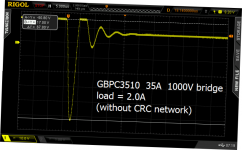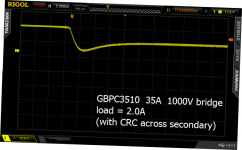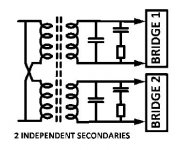Back in '81, I was a test engineer for the largest diode manufacturer on the planet, we shipped 4 million diodes per day. And surface mount didn't exist.
I also handled customer returns, I had to verify the failure noted by the customer, such as HTRB, leakage, breakdown, etc.. Once I verified some parts as failing HTRB, which was the most difficult test.. then about 6 months later, I got the exact same batch from another customer, failing some other test. I ended up seeing those parts three times as customer rejects.
I asked the sales guys what was going on. Turns out, they have a list of customers, hardest to please at the top, with easier to please further down the list. They would go down the ladder three times max, and if the parts were rejected three times, they would collect them in a 50 gallon drum with a large plastic bag liner, and sell them to a single, bottom feeding customer. The customer would derate voltage, current, and put them in blister paks to hang on the wall. No testing.
EVEN DIODES WITH THE MARKING BAND ON THE WRONG END!!
Be wary of your vendor..
John
Yup. double that coming from China, risk wise. I'm not so cheap I wont pay 4 bucks to get a genuine part from a trusted source instead of 1.69 for who knows what. Peace of mind is worth something and I only need two per amp unless dual mono, then only four.
Russellc
Looking at here
KBPC3510 ??????, KBPC3510 Datasheet PDF
I see many manufacturers of this generic part. Most of them are unfamiliar to me.
DC Components itself appear to be a manufacturer in Taiwan and it may
be that it's just too small to have much of a distribution channel in North
America.
KBPC3510 ??????, KBPC3510 Datasheet PDF
I see many manufacturers of this generic part. Most of them are unfamiliar to me.
DC Components itself appear to be a manufacturer in Taiwan and it may
be that it's just too small to have much of a distribution channel in North
America.
First time that some parts are lot cheaper in EU 
And they are not much more in any local store.
If someone doesn't need 35A, easier to build from 4 diodes.
But many times doesn't worth the time to solder them together, just buy that and that is it.
Many shops just bought huge amount of the biggest available so they are cheaper than the lower (V/A) rated similar versions.
And they are not much more in any local store.
If someone doesn't need 35A, easier to build from 4 diodes.
But many times doesn't worth the time to solder them together, just buy that and that is it.
Many shops just bought huge amount of the biggest available so they are cheaper than the lower (V/A) rated similar versions.
Last edited:
Last year I experimented with a couple of 35A 1000V bridge rectifiers made by Diodes Inc (datasheet). They were purchased from DigiKey so I don't think they were counterfeits or gray market devices or test rejects.
I found that the switch-off transient of these rectifiers induced a huge voltage spike in my transformer secondary. One representative experiment (of many) is shown below; the scope is displaying the transformer secondary voltage at the moment when the rectifier shuts off. The secondary voltage was about 17V when the diode shut off (cursor B) and the rectifier-induced voltage spike was more than 67 volts! (cursor A minus cursor B). A factor of 3.9X!
The second photo shows the same diode and the same transformer and the same load, with the addition of a CRC "snubber" network connected across the secondary. This reduced the magnitude of the peak, and damped out the oscillation.
I experimented with a few other bridge rectifiers (8A, 15A, 25A) as well. These were in the GBU and GBJ packages. They exhibited the same general behavior, big spike down plus ringing, as the 35A bridge. Unsurprisingly the 35A godfather device was noisier than all the others.
Would Vishay-made bridge rectifiers be worse, better, or the same? I don't know. Would "DC Components" branded bridge rectifiers be worse, better, or the same? I also don't know. This isn't a behavior they spec on the datasheet, nor do they measure it at outgoing final-test.
_
I found that the switch-off transient of these rectifiers induced a huge voltage spike in my transformer secondary. One representative experiment (of many) is shown below; the scope is displaying the transformer secondary voltage at the moment when the rectifier shuts off. The secondary voltage was about 17V when the diode shut off (cursor B) and the rectifier-induced voltage spike was more than 67 volts! (cursor A minus cursor B). A factor of 3.9X!
The second photo shows the same diode and the same transformer and the same load, with the addition of a CRC "snubber" network connected across the secondary. This reduced the magnitude of the peak, and damped out the oscillation.
I experimented with a few other bridge rectifiers (8A, 15A, 25A) as well. These were in the GBU and GBJ packages. They exhibited the same general behavior, big spike down plus ringing, as the 35A bridge. Unsurprisingly the 35A godfather device was noisier than all the others.
Would Vishay-made bridge rectifiers be worse, better, or the same? I don't know. Would "DC Components" branded bridge rectifiers be worse, better, or the same? I also don't know. This isn't a behavior they spec on the datasheet, nor do they measure it at outgoing final-test.
_
Attachments
snip...I found that the switch-off transient of these rectifiers induced a huge voltage spike in my transformer secondary. ...snip...
I experimented with a few other bridge rectifiers (8A, 15A, 25A) as well. These were in the GBU and GBJ packages. They exhibited the same general behavior, big spike down plus ringing, as the 35A bridge. Unsurprisingly the 35A godfather device was noisier than all the others.
Nice, thank you for that.
Is it from the circuit inductance discharging due to a 2 uSec offtime? All the offline bridges typically run 2 uSec, I suspect that no matter how hard or soft it lets go, if it's less than 2 uSec, the circuit may still ring.
Are you able to determine if the ringing is characteristic of the circuit parasitics where wire dress/twisting/coupling can lower it, or is it just the winding inductance?
btw, tip your camera to the right a tad...
John
Have you read the article in LA v.10? Lotta details there.
No, I have not. I've been rather occupied with other issues, so have been behind the times.
The blurb looks rather good, I'll have to peruse it someday.
John
Hi there Mark (Johnson),
You seem to recommend a CRC snubber in any case... I'd like to try and see if I hear any difference/improvement.
There's a pic attached here, taken from one of your articles. If fitted like this to the standard First Watt transformer with 2x 18V secondaries (230V/300VA), would you please recommend some values/parts to use? (I'm afaid my knowledge is very basic.)
Also in one thread you recommended APT100S20BG as an overkill unit, would this still be you opinion if wanting to go that route?
You seem to recommend a CRC snubber in any case... I'd like to try and see if I hear any difference/improvement.
There's a pic attached here, taken from one of your articles. If fitted like this to the standard First Watt transformer with 2x 18V secondaries (230V/300VA), would you please recommend some values/parts to use? (I'm afaid my knowledge is very basic.)
Also in one thread you recommended APT100S20BG as an overkill unit, would this still be you opinion if wanting to go that route?
Attachments
- STEP 1: Measure the leakage inductance of each secondary winding of the transformer.
- STEP 2: Look up the zero-bias capacitance of the rectifier you plan to use; either in the datasheet or in the SPICE model (parameter name = CJO)
- STEP 3: Choose a value for Cx, the snubber capacitor straight across the secondary. Make certain you choose a Cx value which is larger than (4 * Crectifier). Many diyAudio members find that Cx = 10 nanofarads meets this requirement for the rectifiers they have chosen. Be sure to select a capacitor which can tolerate the full secondary voltage.
- STEP 4: Choose a value for Cs, the capacitor in series with the snubber resistor. Make certain you choose a Cs value which is at least (15 * Cx). For those people who have chosen Cx = 10 nanofarads, Cs = 150 nanofarads is often a convenient value. Be sure to select a capacitor which can tolerate the full secondary voltage
- STEP 5: Choose a value for Rs, the snubber resistor which is in series with Cs. Select it according to the equation
Rs = (0.5 / zeta) * SQRT(LeakageInductance / Cx)
zeta is the damping factor; I suggest you choose zeta=1.00 unless you really know what you are doing. I suggest you select an Rs rated for 1/2 watt or even 1 watt; and I suggest you make it a "flameproof" type of resistor.
Done!
Some people prefer to avoid calculations like the above, so they use the no-Math approach to snubbing called "Quasimodo". It's explained on this website; look for threads with the word Quasimodo in their title, then download the .pdf file attached to post#1 in those threads.
Beware, you will need an oscilloscope. You'll use it in STEP 1 to measure the transformer secondary inductance; OR you'll use it with Quasimodo to select a snubber with no-math. In either case, you will need an oscilloscope.
- STEP 1: Measure the leakage inductance of each secondary winding of the transformer.
Well, I'm stuck here on step STEP 1. Any hints on where to start reading?
One of the articles I was reading includes an option to "let someone else do it" (the math). I'm all about that!
Last edited:
One of the most attractive 23 year old ladies in my circle of friends, used to say "Just get some man to do it for you!" Apparently this worked quite well. For her. Try it yourself, maybe you'll have success. If not you can always fall back on calculus and expensive test equipment.
Or you could make a couple of introductory "probes" and find out how well you do in the barter economy. You have something that PersonX wants, whereas PersonX has something that YOU want. Propose a swap! Maybe the something you have, is a bottle of Veuve Cliquot champagne. Or maybe not! Whatever you and PersonX agree to, becomes the agreement.
Or you could make a couple of introductory "probes" and find out how well you do in the barter economy. You have something that PersonX wants, whereas PersonX has something that YOU want. Propose a swap! Maybe the something you have, is a bottle of Veuve Cliquot champagne. Or maybe not! Whatever you and PersonX agree to, becomes the agreement.
One of the most attractive 23 year old ladies in my circle of friends, used to say "Just get some man to do it for you!" Apparently this worked quite well. For her. Try it yourself, maybe you'll have success. If not you can always fall back on calculus and expensive test equipment.
Or you could make a couple of introductory "probes" and find out how well you do in the barter economy. You have something that PersonX wants, whereas PersonX has something that YOU want. Propose a swap! Maybe the something you have, is a bottle of Veuve Cliquot champagne. Or maybe not! Whatever you and PersonX agree to, becomes the agreement.
That made my day.
BK
Well... I'm stuck on Step 1 also... no oscilloscope. 
Also I haven't been 23 for over 23 years - although when I look in the mirror I do see a very attractive guy. The misses might disagree on this though. But as she doesn’t have an oscilloscope either, I guess I'll have to try to find some guy to impress...
The misses might disagree on this though. But as she doesn’t have an oscilloscope either, I guess I'll have to try to find some guy to impress... 
Also I haven't been 23 for over 23 years - although when I look in the mirror I do see a very attractive guy.
Well... I'm stuck on Step 1 also... no oscilloscope.
Also I haven't been 23 for over 23 years - although when I look in the mirror I do see a very attractive guy.The misses might disagree on this though. But as she doesn’t have an oscilloscope either, I guess I'll have to try to find some guy to impress...

I just wonder who that guy might be???????
http://www.diyaudio.com/forums/power-supplies/243100-simple-no-math-transformer-snubber-using-quasimodo-test-jig.html
Intriguing, I have all the parts, I'm just a little shy on time and ability.
I wonder if anyone out there wants to sell their old test jig?
Regards,
Dan
Intriguing, I have all the parts, I'm just a little shy on time and ability.
I wonder if anyone out there wants to sell their old test jig?
Regards,
Dan
Last edited:
- Status
- This old topic is closed. If you want to reopen this topic, contact a moderator using the "Report Post" button.
- Home
- Amplifiers
- Pass Labs
- Rectifier swapping


